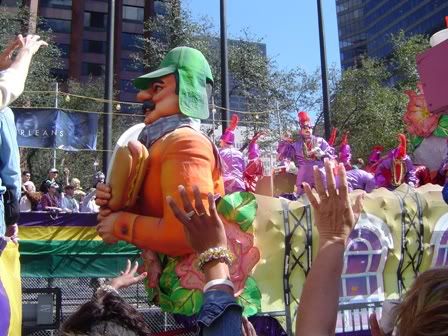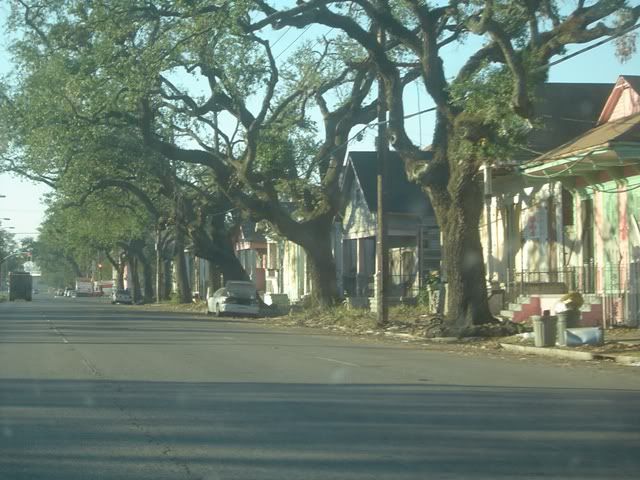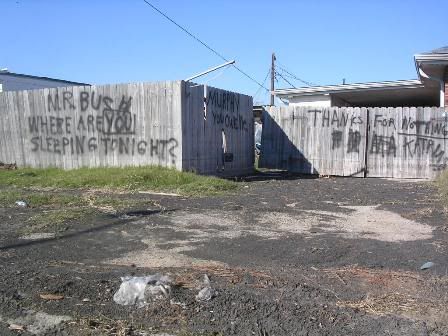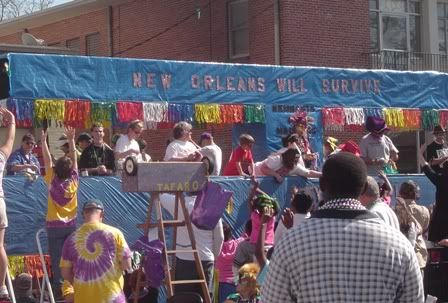(3 pm – promoted by ek hornbeck)
A rambling riff on the oddness of New Orleans as part of this cycle’s NOLA/Gulf Blogathon, organized by Louisiana 1976 over at dkos…

New Orleans was a city doomed to its oddball status from the start. Just look at its original name: la Nouvelle-Orléans. Even the grammar’s wrong, since ‘correct’ French would yield a masculine name rather than a feminine one. But apparently none of the founders even considered le Nouvel-Orléans – their earliest plans, before the first doomed-to-sinkage foundation had been laid, give us the odd feminine name, ensuring us a history of grammatical confusion.
Its difference is encoded in some other languages, too. In Russian, places like New York, New Hampshire, New Jersey, and New Brunswick are all given the ugly “nyoo” as a way of approximating the English word “New”. New Orleans gets the actual Russian word for “new”, the beautiful “novyi”. Nyoo York or Nyoo Dzherzy, but Novyi Orlean. They get the difference.
The city was a disaster from the start. Describing the city under Spanish rule in 1795, Christina Vella writes,
And here, by all accounts, were streets so incredibly foul that sometimes even carriages could not get through them. They were choked with garbage, filthy as sewers, and always wet. Dogs, pigs, and cows roamed about; their dung was never taken away. Privies overflowed, even those of the Ursuline nuns, whose waste, according to the cabildo [the seat of government], “empties directly into the public street.” The road itself served as a toilet when no other was convenient.
In other words, not especially different than a really busy Mardi Gras season, although with less traffic. Plus ça change and all that.

It’s a city easy to romanticize for its colorful history of pirates and prostitutes, the facts often stranger than the fictions. Every street corner has a story, and if a local doesn’t know it, he’ll gladly invent one on the spot. This was the absinthe capital of the world, where O. Henry got his nickname and Faulkner struggled with his first novel, and a red-light district was giving birth to a new type of music that would shake the world.
It’s also easy enough to get lost in that romance and forget that it cost the lives of thousands of slaves who passed through the city on their way to a lifetime of cruel servitude. Here’s what local novelist Baron von Reizenstein had to say in 1865:
New Orleans is the spring from which so many thousands have drawn their wealth, but it is also a bitter cup of suffering, misery, and despair. New Orleans is now the prima donna of the South, the whore insatiable in her embraces, letting go of her victims only after the last drop of blood has been drained and their innermost marrow of life sucked draw… It is a vast grave for poor immigrants and the homeless, who can never extract themselves in time from the arms of this prostitute. Here the chains of a maligned race rattle day and night with no advocate for their human rights.
Again, plus ça change. The city has never effectively dealt with its racial issues, and it’s no easy task to shoulder the weight of nearly 300 years of inequality. Whatever Katrina may have shown the rest of the world, its effect in New Orleans was undeniable: grumbling unease became buried racism, buried racism became overt racism, and nowadays all bets are off.
For some people. For others, catastrophe meant coming together and gaining strength from our shared past. This is a city that held a celebratory funeral for itself, including dancing in the streets to the accompaniment of a brass band – and if you can wrap your head around those contradictions, you’re a little closer to understanding why some of us fight so hard not to let it slip away.
As always, the beauty is in the details.
When the city shut down after the storm and citizens were forceably evacuated, do you know what the sole downtown establishment allowed to remain open was? A strip club. To entertain the relief workers. Chris Rose wrote in confusion, “Exactly how a posse of exotic dancers were smuggled into town during the most severe lockdown of the city since the hurricane crises began, well, I don’t know.”
When people had to gut their homes and throw their lives out into the streets, they turned it into art. Refrigerators became an ongoing dialogue, as did any wall or fence with enough room for a pithy bit of graffiti.

When the owners of the Camellia Grill announced they weren’t going to reopen after the storm, can you guess what happened? Post-it notes. People plastered the front façade of the building with post-it notes wishing them a fond farewell and heartfelt thank you. (It has since reopened under new ownership).
Heck – this is a town where people went nuts to buy insignia from a local drugstore when it went out of business back in 1998. I’m not sure what one does with a giant vomit-purple sign, but I guarantee that locals smile whenever the new owner puts it on display. We’re a little weird like that.
This oddball little city doesn’t stand a chance in a world that’s rapidly shrinking and becoming more homogeneous by the day. Katrina may have just accelerated a process that was already tearing down the city like a million slow-moving termites. Water works more quickly than contractors.
But it all depends on the people.
That means you, too, by the way. There’s so much you can do to help rebuild this town, and it’s never too late to get involved. My last NOLA diary was a list of action items, but the one that most bears repeating came in a comment at dkos from Via Chicago: GO!
Go spend a few days, a week, or more volunteering with one of the many relief agencies. I guarantee you will not regret it.
What I got in return for spending a week working hard was far greater than what I gave.
In addition to feeling good from doing real work with tangible results, I surprisingly felt like I got the most valuable kind of relief from the stress of my every day job than I’ve ever had. It was a true vacation from the every day, and I did not feel at all like I “wasted” a week that could have been spent on a beach somewhere or touring a foreign city.
So, go! Work hard, and by all means don’t feel guilty having a little fun while you’re down there!
here’s a small sample of organizations that can use your help:
http://www.habitat-nola.org/
http://www.lowernine.org/
http://www.onsiterelief.com/
http://animalrescueneworleans….
http://www.emergencycommunitie…
I agree: GO!
What are you waiting for? Our swampy, grammatically-challenged, absinthe-soaked, eccentric little town needs you!

And don’t forget our friends all up and down the Gulf Coast. Katrina slammed communities as far east as Mobile, and with Hurricane Rita affected towns as far West as Texas. You can literally drive for hours and never leave the area of impact. A lot of people still need you.
+++++
All the texts are linked back to their sources except for one that’s not readily available: For info on the city’s oddly gendered name, the best reference I could find is a 1951 article – “L’Abbé Prévost and the Gender of New Orleans” – by William Woods of Tulane University in Modern Language Notes, Vol. 66, No. 4 (Apr., 1951), pp. 259-261. If you have access to JSTOR, you can also read it there.
Cross-posted at dkos.

11 comments
Skip to comment form
Author
seems appropriate here:
Thumbs up.
A now deceased friend of mine lived for a long time on Royal Street. One night in 1974 when her consciousness was altered in an unusually profound and fuzzy way, she parked her car somewhere, walked home and fell asleep. The next day she couldn’t find the car, so she wandered the streets near her house, still couldn’t find it, and eventually, reported it stolen. She was really sad about the loss of her car. Afterwards, she walked everywhere she couldn’t take public trans.
About four months later, she and I and another friend went out to dinner. Afterwards, we went for a walk in the neighborhood. Up toward Rampart Street, parked in a legal spot at the curb was a dirty but otherwise ordinary car that looked a lot to all of us like the stolen one. It appeared not to have been driven in some time. Was it her car? To our delight, her key opened the door and it fit in the ignition. But the battery, alas, was dead. The three of us paid strict attention to where the car was. I think my friend wrote it down. And the next day, we came back. The car hadn’t been moved. We jump started it, and she drove it home.
To this day, 34 years later, I have no idea whether the car was stolen and that we recovered it, or whether she just forgot where she parked it. New Orleans to me is like that. Maybe that’s why I love it so much.
I was touched by the von Reizenstein quote. My heart goes out to all the people of New Orleans, those scattered to the four winds and those who remain to bring the city back. More power to them all. For me, the people always make the place.